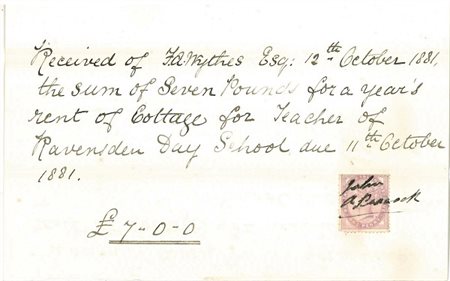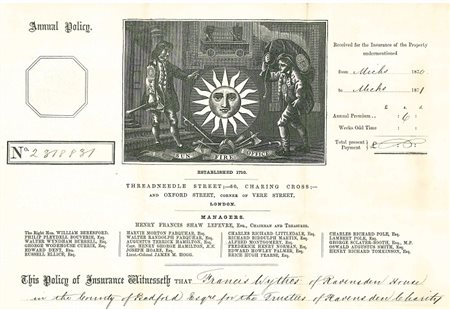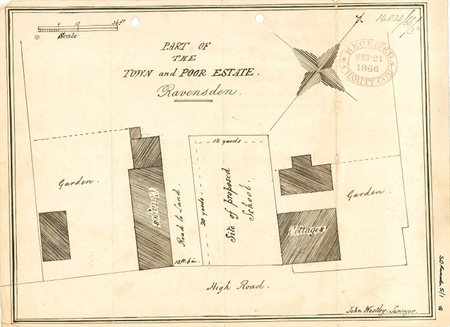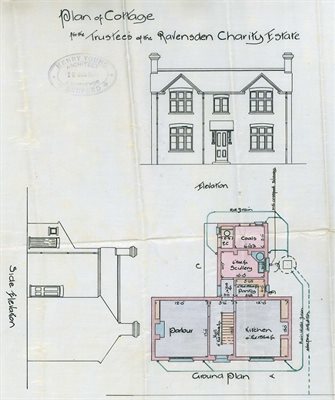The School Master's House
When the school managers first wished to build a school they also wanted to build a house for the teacher of that school. In the deed that conveyed the land from the trustees of the charity to the managers of the school in 1866 the land is described as ‘to be applied as a site for a School for poor persons of and in the Parish of Ravensden aforesaid and for the Residence of the School-master and School-mistress of the said School’. However, funding being tight no house for the school teacher was built.
A cottage was provided for the school teacher from at least 1879 and probably from 1876, but this was an existing property in Church End. We know from the letters of Emily Smith that she anticipated having to move house in March 1881 and that in October 1881 she complained to the managers that her house was too small. According to the land valuations of 1876-1881 George Smith occupied a house and land at Church End belonging to John Peacock and this is supported by the vouchers of payments made to J Peacock in 1879-80 and J A Peacock in 1881-82 by the school managers for rent for a cottage for the school teacher.

Receipt for rent of a cottage for school teacher, 12th October 1881 (SDRavensden4/12/12)
Trevor Stewart has found that in a memoir of an elderly Ravensden born resident (Mr. Bill Cambers) written in the early 1960s, Mr Camber’s mother ‘’remembered the old school burning down but being rebuilt.’’ This memory may refer to the fire that destroyed two cottages belonging to the Town and Poor Estate charity at about a quarter to four o’clock on the morning of Monday 14th November 1881. According to newspaper reports of the time ‘a stack of straw was on fire in close proximity to the cottages occupied by William Rust and William Horrell, nearly opposite the church. A sharp wind was blowing towards the cottages and almost as soon as the flames were seen they crept round the straw stack and leapt across to the thatched roof of the nearest cottage that occupied by Rust. Plenty on assistance was soon at hand, and efforts were made to stop the flames, but to no effect and though a ready supply of water was at hand and freely used, the wind successed in urging on the flames, and in carrying fire over the road, a distance of fifty yards, to the roof of a row of a dozen thatched houses. On seeing this, mounted messengers were despatched to Bedford, for the Volunteer Fire Brigade. As quickly as possible four horses were put to the engine, and a start was made for the scene of fire; on arrival, the brigade found the roofs in, and the whole structures doomed. Capt Thody at once directed the efforts of the force to preventing the spread of the fire, and then to the demolition of the two cottages, such being the only course to ensure safety. From the Brigade enquiries we learn that the fire was first seen by Horrell, who, being unwell, had been downstairs about half past three, when all was right and safe. He returned to bed, and by a quarter to four his notice was attracted by the light of fire; and rousing his wife and family at once, most of his furniture was saved: this was extremely fortunate, as the poor old man was not insured. As to the other occupier, Rust, he was awaked by his son, who slept with him, the boy having to get to work a mile or so away from home at half-past-four. These two had no time to remove any of the contents of their house, and the whole were destroyed. Fortunately, Rust was able to get safely away his pigs, before the stye was burnt; with this exception, everything both in and out of the house, belonging to him was destroyed. By eight o’clock further danger was over and the Fire Brigade returned to Bedford, leaving two labourers to clear all wood away, and remove it to a safe distance. The property belongs to the Ravensden Charity, and is insured in the Sun Fire Office; Rust was insured in the Manchester Fire Office. The damage is estimated at about £250.’ (Leighton Buzzard Observer 22 Nov 1881 page 5 col 6)

Sun Insurance Policy for the cottages (P89/25/2)
On the original insurance policy of 1870 the cottages of the charity, which stood on the land to the south-west of the school, were described as follows:
Two cottages adjoining situate as above thatched £45 on each. Two Barns adjoining to the above thatched. Two Cottages adjoining near Brick & tiled £45 on each Two Barns adjoining to the last above Brick & tiled. The charity claimed on its insurance and received a cheque for £90, but did not then rebuild the destroyed cottages (P89/25/2).

The 1866 plan shows the cottages that burnt down to the left of the proposed school site. (SDRavensden5/1G)
The school log book records that ‘Only 26 children at school this morning a fire has occurred close to the school premises, which from information received has deterred some of the parents from sending their children.’ It was not until September 1898 that the trustees asked the Charity Commissioners whether they could use their funds to build a cottage – to which the reply was that the Commissioners did not, as a rule, view with favour a proposal to expend Charity Funds in the erection of cottages. Negotiations continued and in November 1902 the Charity Commissioners made an order that as ‘it has been considered desirable to build a cottage at Ravensden, on the site of some cottages destroyed by fire’ at a cost of £290 the trustees may appropriate £225 on deposit in the Bedford Savings Bank and raise a loan of £65 (P89/25/15/44).
The house was to be built to the plans prepared by Henry Young, architect of Bedford, dated 28 January 1902 (P89/25/1/3).

Elevation of cottage by Henry Young, 28 January 1902 (P89/25/1/3)
The school managers passed a motion ‘that the Clerk be asked to write the Trustees of Ravensden Charity and say in the event of their building a house at Ravensden the Managers of Ravensden School would be glad to offer for the tenancy of the same a rental of about £12 a year for three years, and after on a yearly tenancy.'
It seems the house was not completed until 1904 as the Clerk to the County Council, on the council’s taking over maintenance of Ravensden School, declared it could not do the papering of the Schoolmaster's House. 'He said he did not at all think the County Council would have sanctioned the renting of the house had they thought there would be any initial expense. It was expected the house was completed. The renewing of the paper in after years was a different matter...' (P89/25/16/26)
In 1925 the district valuer described the school master’s house as ‘Very Superior’ having 2 Rooms (grates) kitchen and scullery combined (copper & range) Pantry, and 3 Bedrooms. Water Pump in Scullery, Drain Cess Pit. Out Coal Place, Privy, Washhouse & Garage (DV1/93p66)
The house remained the property of the Ravensden Town and Poor Estate charity whereas the school next door was the property of the school managers.